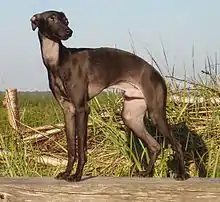Italian Greyhound
The Italian Greyhound (Italian: Piccolo levriero Italiano) is an Italian breed of small sighthound.[2] It may also be called the Italian Sighthound.
| Italian Greyhound | |||||||||||||
|---|---|---|---|---|---|---|---|---|---|---|---|---|---|
.jpg.webp) | |||||||||||||
| Other names |
| ||||||||||||
| Origin | Italy | ||||||||||||
| |||||||||||||
| |||||||||||||
| Dog (domestic dog) | |||||||||||||
History
.jpg.webp)
This dog has long been popular with nobility and royalty. Among those believed to have kept it are Frederick II, Duke of Swabia; members of the D'Este, Medici and Visconti families; the French kings Louis XI, Charles VIII, Charles IX, Louis XIII and Louis XIV;[3] Frederick the Great of Prussia;[4]:519 Anne of Denmark; Catherine the Great and Queen Victoria.[5]
The breed has often been represented in paintings, notably by Giotto, Sassetta and Tiepolo.[3]
Characteristics
The Italian Greyhound is the smallest[6] of the sighthounds. It weighs no more than 5 kg (11 lb) and stands 32 to 38 cm (13 to 15 in) at the withers.[1] It is in the Sighthound Group of the Fédération Cynologique Internationale,[7] but in the Toy Group of the American Kennel Club[8] and The Kennel Club (UK).[9]
It is deep in the chest, with a tucked-up abdomen, long slender legs and a long neck that tapers down to a small head. The head is long and pointed.[1] The gait should be high-stepping and well-sprung, with good forward extension in the trot, and a fast gallop.[3]
All colours are accepted except brindle or black and tan. Recognised coat colours include black, seal, blue, fawn, and red; In Europe, white markings are accepted on the chest and feet only.[3]
Health

The Italian Greyhound has a median lifespan of 13.5 in a 2004 UK Kennel Club survey.[10] A 1993 US breed club survey gives an average lifespan of 9 years, but more than a quarter of the dogs had "accidents" recorded as the cause of death.
Health problems that can be found in the breed:[11]
- epilepsy
- Legg-Perthes disease (degeneration of the hip)
- patellar luxation (slipped stifles)
- von Willebrand disease (Bleeding disorder)
- progressive retinal atrophy
- color dilution alopecia (hair loss in dilute pigmented dogs; i.e., blues, blue fawns, etc.)
- leg breaks (most common under the age of 2)
- cataracts
- vitreous degeneration
- liver shunts
- autoimmune hemolytic anemia
- periodontal disease, gum recession, early tooth loss, bad tooth enamel
- hypothyroidism, autoimmune thyroid disease (Hashimoto's disease)
The Ortheopedic Foundation for Animals has found the Italian Greyhound to be the least affected by hip dysplasia of 157 breeds studied, with an incidence of 0.[12]
See also
References
- Piccolo levriero italiano: Storia (in Italian). Ente Nazionale della Cinofilia Italiana. Accessed February 2020.
- Barber, Lillian S., The New Complete Italian Greyhound, p. 5 (1993, Italian Greyhound Productions) ISBN 0-9611986-2-1
- Piccolo levriero italiano (in Italian). Ente Nazionale della Cinofilia Italiana. Accessed February 2020.
- Desmond Morris (2001). Dogs: A Dictionary of Dog Breeds. London: Ebury. ISBN 9780091870911.
- "Italian Greyhound". American Kennel Club. Retrieved 23 February 2019.
- "Italian Greyhound Did You Know?". AKC.org. American Kennel Club. Retrieved 13 April 2014.
- Piccolo levriero italiano (200). Fédération Cynologique Internationale. Accessed February 2020.
- "Italian Greyhound Dog Breed Information". American Kennel Club. Retrieved 2020-03-06.
- "The Kennel Club". www.thekennelclub.org.uk. Retrieved 2020-03-06.
- "Breed Longevity Data".
- Dickinson, Teri. "Health concerns". Italian Greyhound Club of America. Archived from the original on 5 April 2014. Retrieved 13 April 2014.
- "Hip Dysplasia Statistics: Hip Dysplasia by Breed". Ortheopedic Foundation for Animals. Archived from the original on 2010-02-10. Retrieved 2010-02-10.
External links
 Media related to Italian Greyhound at Wikimedia Commons
Media related to Italian Greyhound at Wikimedia Commons